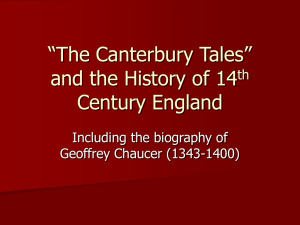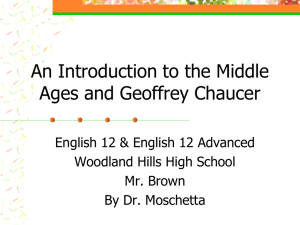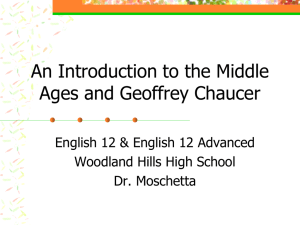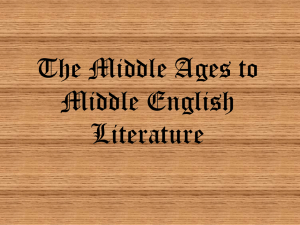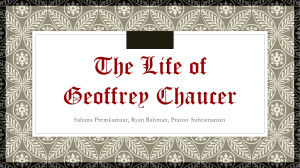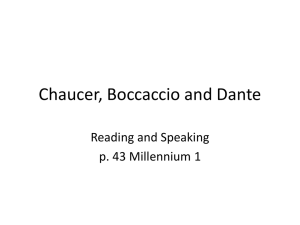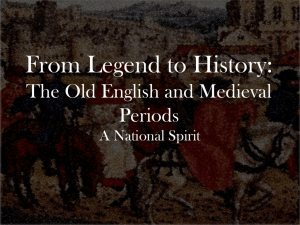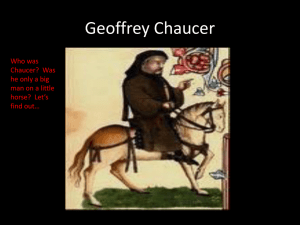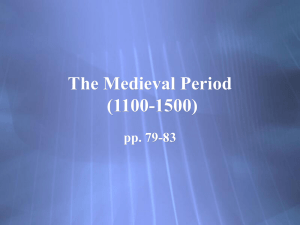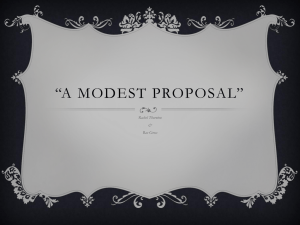Geoffrey Chaucer`s - Professor Beamen`s Website
advertisement
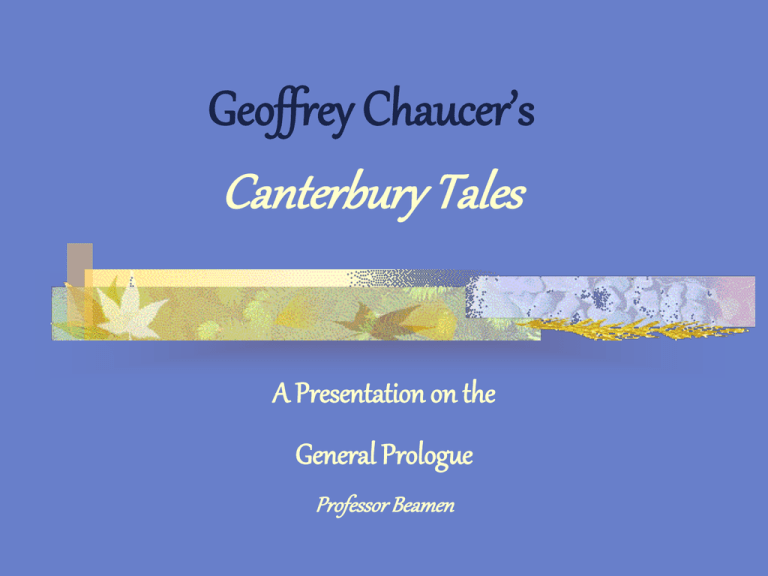
Geoffrey Chaucer’s Canterbury Tales A Presentation on the General Prologue Professor Beamen Chaucer’s Background (1343? –1400) Known as “the Father of English Poetry” His father was a wine merchant, so he was neither an aristocrat nor a peasant In his lifetime he was a page in a royal house, soldier, diplomat, and royal clerk, so he had a perfect vantage point for observing all kinds of people. Chaucer’s background (cont’d) When Chaucer was a diplomat, one of his tasks was to go abroad; in doing so he brought back influence of writers, the most important of which was Boccaccio’s Decameron. Many critics say Chaucer did not borrow from Boccaccio, but even if he did, Shakespeare was guilty of this same imitatio. Chaucer was called “English Homer” by Renaissance historians, and evolved into the forefather figure of Renaissance English literary history (Miskimin 58) Chaucer’s Middle English Even while Chaucer visits old genres, he is perfecting a new poetic form. In the Middle Ages, the meters and sound effects of Old English no longer suited the English language. He adapted French poetic forms to the English language. Basis of the Pilgrimage Chaucer’s own house in London overlooked the pilgrim road that led to Canterbury. The pilgrims are on their way to the shrine of St. Thomas à Becket, who was appointed Archbishop of Canterbury by Henry II. Becket was famous for his struggle to keep the English church free from royal control, which caused tension between him and Henry II (who eventually had Becket killed). The shrine built to honor him was later destroyed by Henry VIII. “The detail with which Chaucer devotes to his accounts of the normal life of each pilgrim, serves, by implication, to emphasize the departure from those lives represented by the pilgrimage itself” (Martin 55) Literary Elements Social Commentary This later bloomed with the invention of the novel Human nature changes very little (from then until now) Direct and Indirect Characterization Chaucer presents “an astonishing individuality and variety—of behavior, of posture, of complexion, even…of clothing…” (Nevo 9) Chaucer’s point was to sharpen our overall perceptions on the basis of everyday attitudes toward people, of the things we take into account and the things we willingly ignore (Mann 25). The description of the various pilgrims turns rapidly from an article of clothing to a point of character and back again with no apparent organization. Yet this artful artlessness is so effective that each pilgrim stands out sharply as a type of medieval personality and also as a highly individualized character. (Hopper 92) The Prologue There are three basic estates: Aristocracy (the Knight, Squire, Yeoman) Clergy (Prioress, Monk, Friar) Commons (all the rest) In the Prologue, the pilgrims’ views are not individual ones, but attached to their callings—in medieval terms, their estates. The Prologue is a poem about work as social experience conditions personality and then a standpoint from which an individual views the world (Mann 36). Chaucer (the author) and his Point of View Chaucer not only persuades us that fools and rascals can be very charming people, but he is at the same time making us suspect that they are fools and rascals. Chaucer aware that there ought to be meaning in everything; his works in general contained a lot of proverbs. In his works he hints that chivalry is breaking down. Canterbury Tales represents rising middle class. Chaucer as Narrator Chaucer applies a double irony in appearing as himself masked in the masquerade. The narrator himself constantly identifies with the pilgrims’ point of view and encourages us to see the world from this angle; a large part of the narrator’s criteria for judging is personal, based on pleasantness, charm, and social accomplishments. (Mann 30) Chaucer the pilgrim, the naive narrator of the Prologue, so often misses the point of the complex phenomena he describes in order that Chaucer the satirist or the poet or the man can make sure WE see how very complex they are (Leicester 95). Money in the Prologue Every character has a mention of, or a connection to, money! Pilgrims are described in terms of how they make a living or how they go about spending money, or some form of array. (Eberle 114) The Prologue is a classification of society based on the various sources of income in which the pilgrimage is a structural frame (Nevo 14). The Prologue is a symbol for “cupidity” Chaucer assumes his audience has a lively interest in the world of getting and spending money as well as commerce; which he neither praises nor condemns; rather, he takes it for granted (Eberle 115) . Money in the Prologue (cont’d) “Gold” plays a big role in the Prologue— See Prioress (St. Loy), Monk (his brooch), Clerk, Doctor, etc. Sumptuary Laws: dictated what people could wear: fabrics, decorations, etc. Clothing was a uniform for some; to what extent does it define personality? Characters Pilgrims in Canterbury Tales(blank).doc “Except for the Knight, Parson, Plowman, and scholar, …these pilgrims are totally taken up with the world and the flesh.” (Nevo 17) “Like the Friar, Summoner, and Pardoner, Harry Bailey knows how to turn a tidy profit from a religious occasion like a pilgrimage. He comes up with the idea, for which someone else will have to pay; meanwhile he’ll collect the profits (Eberle 121). Why are these pilgrims on this journey? With whom would you choose to ride? The Pardoner’s Tale Exemplum, archetypal narrative elements Ironically, the Pardoner’s own tale confirms the connection of symbols and controls. It concerns the young rioters who reject both. The rioters, who have little sense of symbolism, do not acknowledge loyalty to any abstraction like a social unit, even one of their own making. It is in this sense that it is a moral tale. The windy sermonizing in the Pardoner’s Tale—words unnecessary to the plot itself—recalls a modern idea that words are not the things they stand for. Words are a symbolic order apart from reality. The pardoner finds it easy to exploit the falsity inherent in language. (Justman 130) Pardoner’s Tale (cont’d) The Pardoner has defeated any attempt to trick his companions by exposing his greed before the tale is told. What the Pardoner says to others partly reflects what he is already is and what he will be. Chaucer suggests transformations through the effect of the language of the tale he chooses to tell (Bloom 3). The audience, in a spirit of penance from the pilgrimage, alters his audience's perspective of his tale (Martin 58) Harry Bailey is the only pilgrim who doesn’t seem to understand this; he gives a violent verbal attack. The End Works Cited Bloom, Harold. “Introduction.” Modern Critical Interpretations: Geoffrey Chaucer’s The General Prologue to the Canterbury Tales. Ed. Harold Bloom,. New York: Chelsea House Publishers, 1988. 4-7. Print. Bloomfield, Morton W. “The Canterbury Tales as Framed Narratives.” Modern Critical Interpretations: Geoffrey Chaucer’s The General Prologue to the Canterbury Tales. Ed. Harold Bloom,. New York: Chelsea House Publishers, 1988. 101-112. Print. Chaucer’s Canterbury Tales (Selected): An Interlinear Translation. Ed. Vincent Foster Hopper. New York: Barron’s Educational Series. 1970. Print. Eberle, Patricia J. “Commercial Language and the Commercial Outlook in the General Prologue.” Modern Critical Interpretations: Geoffrey Chaucer’s The General Prologue to the Canterbury Tales. Ed. Harold Bloom,. New York: Chelsea House Publishers, 1988. 113-124. Print. Justman, Stewart. “Literal and Symbolic in the Canterbury Tales.” Modern Critical Views: Geoffrey Chaucer. Ed. Harold Bloom. New York: Chelsea House Publishers, 1985. 57-78. Print. Leicester, H. Marshall. “The Art of Impersonation: A General Prologue to the Canterbury Tales.” Modern Critical Interpretations: Geoffrey Chaucer’s The General Prologue to the Canterbury Tales. Ed. Harold Bloom,. New York: Chelsea House Publishers, 1988. 85-100. Print. Mann, Jill. “Medieval Estates Satire and the General Prologue” Modern Critical Interpretations: Geoffrey Chaucer’s The General Prologue to the Canterbury Tales. Ed. Harold Bloom,. New York: Chelsea House Publishers, 1988. 21-36. Print. Martin, Loy D. “History and Form in the General Prologue.” Modern Critical Interpretations: Geoffrey Chaucer’s The General Prologue to the Canterbury Tales. Ed. Harold Bloom,. New York: Chelsea House Publishers, 1988. 51-66 Print. Miskiman, Alice S. “From Medieval to Renaissance: Some Problems in Historical Criticism.” Modern Critical Views: Geoffrey Chaucer. Ed. Harold Bloom. New York: Chelsea House Publishers, 1985. 57-78. Print. Nevo, Ruth. “Chaucer: Motive and Mask in the General Prologue.” Modern Critical Interpretations: Geoffrey Chaucer’s The General Prologue to the Canterbury Tales. Ed. Harold Bloom,. New York: Chelsea House Publishers, 1988. 9-20. Print. Nolan, Barbara. “ ‘A Poet Ther Was’: Chaucer’s Voices in the General Prologue to The Canterbury Tales.” Modern Critical Interpretations: Geoffrey Chaucer’s The General Prologue to the Canterbury Tales. Ed. Harold Bloom,. New York: Chelsea House Publishers, 1988. 125-148. Print. Parker, David. “Can We Trust the Wife of Bath?” Modern Critical Views: Geoffrey Chaucer. Ed. Harold Bloom. New York: Chelsea House Publishers, 1985. 49-56. Print.
